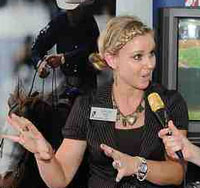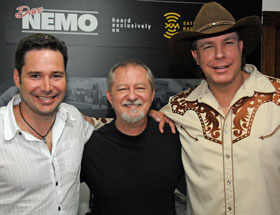 The 2009 New Holland Celebrity Tractor Show, hosted by Michael Peterson, has concluded and we have a two time winner!
The 2009 New Holland Celebrity Tractor Show, hosted by Michael Peterson, has concluded and we have a two time winner!
He’s Darby Ledbetter, seen here with his wife, being interviewed by Cindy. I think Darby was pretty excited and did a victory lap with the checkered flag. I’ve updated the online photo album for your viewing pleasure. I’ll be posting more over the next couple days since I’m heading off to Denver immediately for the AFBF Public Relations conference. It’s going to be a busy week for AgWired.
Thank you Gene Hemphill, Dawn Fox, New Holland and Holly and John Fritz, H. B. Fritz & Associates for another fantastic week in country music city.
2009 CMA Music Festival Photo Album
You can listen to Cindy interview our race winner here:

 It has been a great day of country music at the CMA Music Festival in Nashville, TN. We got to watch Michael Peterson perform at Hard Rock Cafe before heading over to LP Field for the evening concert.
It has been a great day of country music at the CMA Music Festival in Nashville, TN. We got to watch Michael Peterson perform at Hard Rock Cafe before heading over to LP Field for the evening concert.
 This year being not only my first CMA Music Festival but also my first time In Nashville, I really didn’t know what to expect. I knew there would be country music stars but was unaware of all the other attractions going on downtown. This festival brings in so many companies with booths and prizes that one day really isn’t enough! There is so much to do from watching the flying dog show to watching street performers like the
This year being not only my first CMA Music Festival but also my first time In Nashville, I really didn’t know what to expect. I knew there would be country music stars but was unaware of all the other attractions going on downtown. This festival brings in so many companies with booths and prizes that one day really isn’t enough! There is so much to do from watching the flying dog show to watching street performers like the  One of the great things about the CMA Music Festival is the opportunity to meet stars of the stage. Michael Peterson introduced me to Ricochet. They were in the kickoff parade and will be competing in the New Holland Celebrity Tractor Race on Sunday.
One of the great things about the CMA Music Festival is the opportunity to meet stars of the stage. Michael Peterson introduced me to Ricochet. They were in the kickoff parade and will be competing in the New Holland Celebrity Tractor Race on Sunday. Sharing a booth with New Holland at the CMA Music Festival in Nashville this year is the
Sharing a booth with New Holland at the CMA Music Festival in Nashville this year is the  APHA is the second largest horse breed registry in the United States with nearly 100,000 members and Ginger says they are a very exceptional horse. “The color really sets them apart, they’re basically a stock horse with color and each one is unique – no two are alike, they’re like a snowflake,” said Ginger. “They’re very fun to ride and they can do all sorts of things.”
APHA is the second largest horse breed registry in the United States with nearly 100,000 members and Ginger says they are a very exceptional horse. “The color really sets them apart, they’re basically a stock horse with color and each one is unique – no two are alike, they’re like a snowflake,” said Ginger. “They’re very fun to ride and they can do all sorts of things.”  For the third year in a row I got to sit in the studio with Joe Jobe, National Biodiesel Board (left) and Michael Peterson (right) while they were guests on the
For the third year in a row I got to sit in the studio with Joe Jobe, National Biodiesel Board (left) and Michael Peterson (right) while they were guests on the 